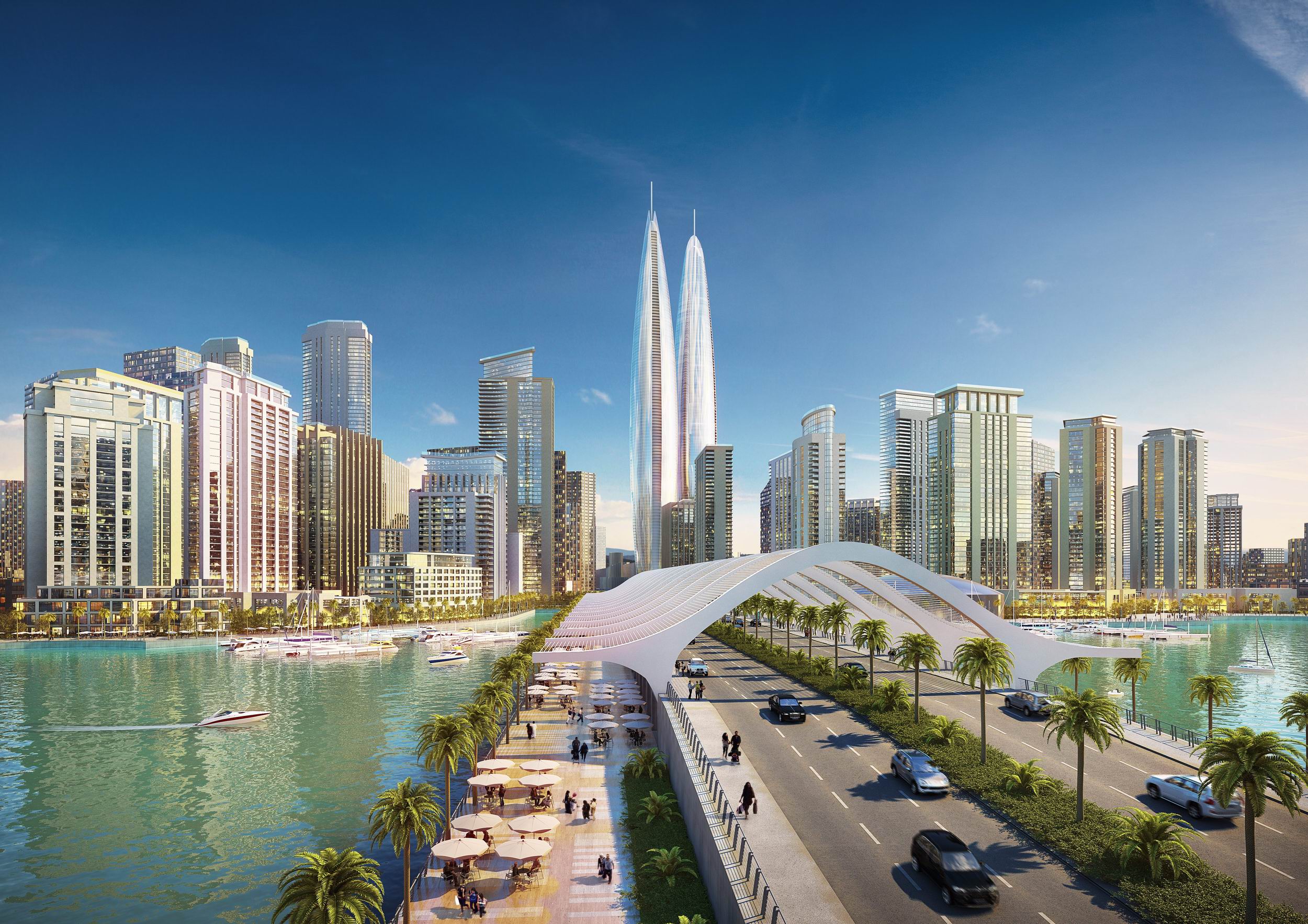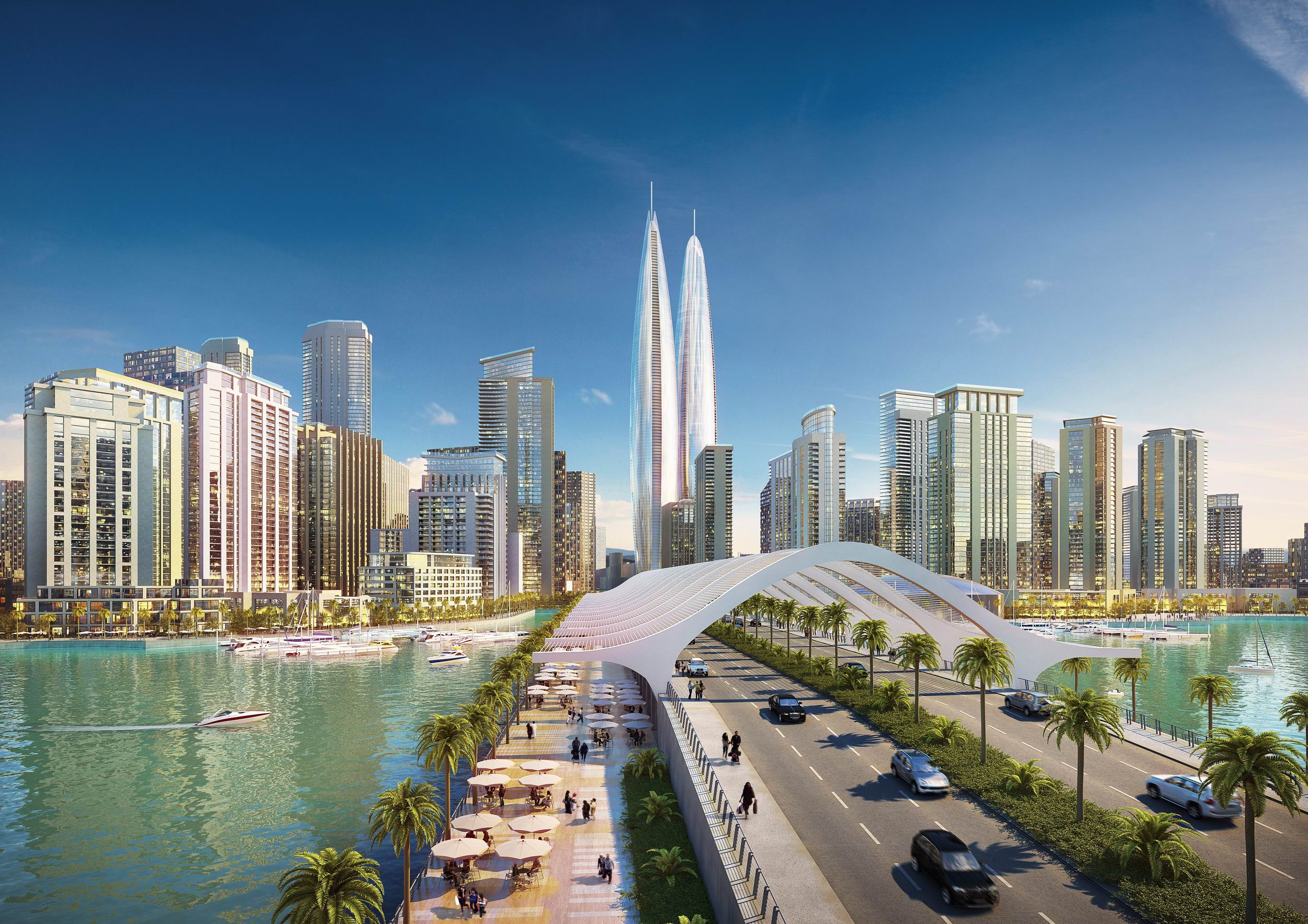Emaar Properties, known for its futuristic approach to buildings, has unveiled plans for a new project containing two towers that will top the charts in height, making them the world’s tallest towers once completed.
Dubai Creek Harbour will boast 39,000 homes and 22 hotels, making it three times the size of its downtown area, which contains the world’s tallest building, Burj Khalifa. Emaar Properties is partnering with Dubai Holding on this project.
Six towers, retail elements, and three hotels will round out Dubai Creek Residences, the first phase of the project, with the twin towers expected to be the centerpiece of the development. The six towers, which are 40 stories tall, will become waterfront properties, and contain one, two, and three bedroom apartments ranging from 880 to 2,154 sf. Dubai Creek Harbour as a whole will encompass 6 million sm (or 1,482 acres).
Starting November 1, apartments in two of the six towers will be available for sale on a first-come first-serve basis in the following locations: Dubai, Abu Dhabi, London, and Moscow.
Chairman of Emaar Properties, Mohamed Alabbar, told The National that the current market will be able to handle this magnitude of a project. “I think all the stakeholders in Dubai in this business learnt their lessons and have matured, the buyer, seller, bank, and regulator,” said Alabbar. “What is boils down to is supply and demand.”
Alabbar also commented to Dubai Holding that the vision of the project, “was to create a dynamic city of the future that integrates smart networks, while building on the cultural heritage of our city.”
Emaar Properties has not released information about the cost of the project, funding requirements, when ground will be broken, or the architect of the project.
For more information, visit www.emaar.com.
Related Stories
| Apr 14, 2011
USGBC debuts LEED for Healthcare
The U.S. Green Building Council (USGBC) introduces its latest green building rating system, LEED for Healthcare. The rating system guides the design and construction of both new buildings and major renovations of existing buildings, and can be applied to inpatient, outpatient and licensed long-term care facilities, medical offices, assisted living facilities and medical education and research centers.
| Apr 13, 2011
National Roofing Contractors Association revises R-value of polyisocyanurate (ISO) insulation
NRCA has updated their R-value recommendation for polyisocyanurate roof insulation with the publication of the 2011 The NRCA Roofing Manual: Membrane Roof Systems.
| Apr 13, 2011
Professor Edward Glaeser, PhD, on how cities are mankind’s greatest invention
Edward Glaeser, PhD, the Fred and Eleanor Glimp Professor of Economics at Harvard University and director of the Taubman Center for State and Local Government and the Rappaport Institute for Greater Boston, as well as the author of Triumph of the City: How Our Greatest Invention Makes Us Richer, Smarter, Healthier, and Happier, on how cities are mankind’s greatest invention.
| Apr 13, 2011
Southern Illinois park pavilion earns LEED Platinum
Erin’s Pavilion, a welcome and visitors center at the 80-acre Edwin Watts Southwind Park in Springfield, Ill., earned LEED Platinum. The new 16,000-sf facility, a joint project between local firm Walton and Associates Architects and the sustainability consulting firm Vertegy, based in St. Louis, serves as a community center and special needs education center, and is named for Erin Elzea, who struggled with disabilities during her life.
| Apr 13, 2011
Virginia hospital’s prescription for green construction: LEED Gold
Rockingham Memorial Hospital in Harrisonburg, Va., is the commonwealth’s first inpatient healthcare facility to earn LEED Gold. The 630,000-sf facility was designed by Earl Swensson Associates, with commissioning consultant SSRCx, both of Nashville.
| Apr 13, 2011
Office interaction was the critical element to Boston buildout
Margulies Perruzzi Architects, Boston, designed the new 11,460-sf offices for consultant Interaction Associates and its nonprofit sister organization, The Interaction Institute for Social Change, inside an old warehouse near Boston’s Seaport Center.
| Apr 13, 2011
Expanded Museum of the Moving Image provides a treat for the eyes
The expansion and renovation of the Museum of the Moving Image in the Astoria section of Queens, N.Y., involved a complete redesign of its first floor and the construction of a three-story 47,000-sf addition.
| Apr 13, 2011
Duke University parking garage driven to LEED certification
People parking their cars inside the new Research Drive garage at Duke University are making history—they’re utilizing the country’s first freestanding LEED-certified parking structure.
| Apr 13, 2011
Red Bull Canada HQ a mix of fluid spaces and high-energy design
The Toronto architecture firm Johnson Chou likes to put a twist on its pared-down interiors, and its work on the headquarters for Red Bull Canada is no exception. The energy drink maker occupies 12,300 sf on the top two floors of a three-story industrial building in Toronto, and the design strategy for its space called for leaving the base building virtually untouched while attention was turned to the interior architecture.
| Apr 13, 2011
Former department store gets new lease on life as MaineHealth HQ
The long-vacant Sears Roebuck building in Portland, Maine, was redeveloped into the corporate headquarters for MaineHealth. Consigli Construction and local firm Harriman Architects + Engineers handled the 14-month fast-track project, transforming the 89,000-sf, four-story facility for just $100/sf.


















